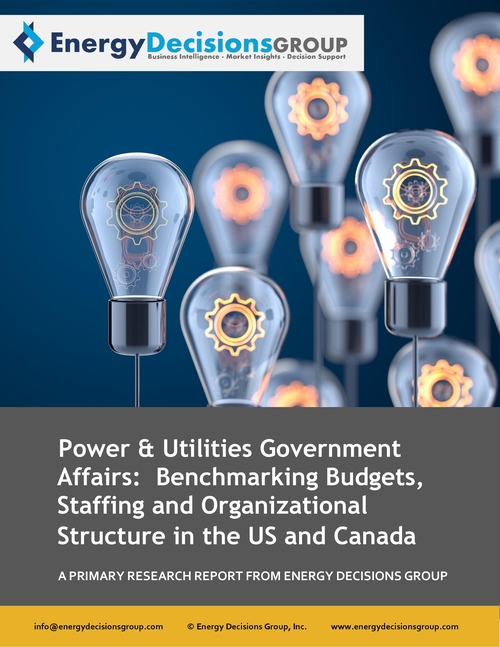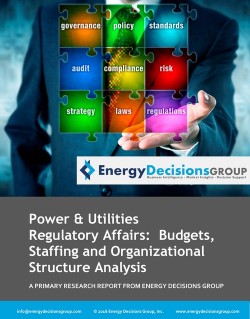Description
Electric power producers and utilities are traditionally highly regulated industries. At federal, state and local levels, numerous policy issues directly impact these companies and their customers. Such issues may include, but are not limited to, environmental regulation, energy security, taxation, and finance reform. As such, electric power producers and utilities have a strong interest in not only staying informed of regulatory policy changes at the federal and state levels, but also influencing policy and regulatory changes.
Government affairs, or government relations, departments are responsible for engaging federal, state and local policy makers; keeping internal and external stakeholder informed of policy changs and how they may impact their business; and identifying, monitoring, analyzing and advocating for energy legislation that may impact the electric power production and distribution sectors. Government affairs functions also are responsible for working with legislators and regulatory authorities to introduce new legislation that will advance their policy positions and foster a more favorable operating environment.
The role of the government affairs, or government relations, function is growing in strategic importance and value given a number of factors in the marketplace, including:
- a quickening pace of regulatory activities and policy changes in many US states and at the federal level,
- a push for greater prioritization of conflicting policy positions among business units, and
- the power of speaking to policymakers with one influential voice.
We developed this report to provide hard-to-find benchmark data on power and utilities companies’ government affairs functions. Specifically, the months-long research effort that culminated in this report examines and compares the budgets, staffing levels, organizational structure composition, and projections for future changes in budgets, staffing and structure of the government affairs functions operating within a variety of power and utilities firms, including independent power producers (IPPs), investor-/privately-owned utilities (IOUs), and public/municipal utilities (MUNIs).
Data and Insights Included in This Report
- Government affairs department budgets, including budget breakdowns into major line items and spending categories
- Projections for changes to government affairs budgets in the coming years, including factors driving those changes
- Government affairs staffing headcounts (internal employees and contract workers) broken down by seniority level
- Trends and analysis of companies’ future plans for staffing in the next few years
- Analysis of government affairs / government relations organizational structures (stand-alone departments vs. multi-functional departments which include other functions, such as regulatory affairs, public affairs, finance, corporate affairs, etc.)
- Comparisons of centralized, decentralized and matrixed organizational structures
- Reporting relationships to executive management
- Plans for re-structuring government affairs departments in the next few years
Why Buy This Report
- Benchmark government affairs budgets and spending practices at power and utilities companies in the US and Canada
- Compare your department’s staffing resources to those of other companies
- Right-size your department’s staffing levels
- Make the case to management for additional budget and staffing resources
- Understand how organizational structure supports or hinders business performance
- Inform decisions about departmental reorganizations
Report Contents:
Executive Summary
Summarizes the key findings of our research and develops implications and recommendations
Analysis of Companies Analyzed and Executives Consulted in This Study
Provides summary information and insights about the companies that we examine in this report and the executives who contributed to this research.
Government Affairs Budget Allocations and Analysis
Includes analysis of government affairs budgets, including breakdowns into major line items and spending categories, as well as projections for future spending changes and analysis of related trends at benchmarked companies.
Government Affairs Organizational Structure Insights and Analysis
Delves into the details of companies’ government affairs organizational structures, including analysis of centralized, decentralized and matrix approaches and the advantages/disadvantages of each; assessments of reporting relationships; and companies’ plans for organizational restructuring in the next few years.
Government Affairs Staffing Levels and Analysis
Includes detailed examinations of government affairs staffing levels, including breakdowns of headcounts (as measured in full-time equivalents, or FTEs) at various levels, as well as breakdowns of in-house employees versus contracted staffers. Includes analysis of the reporting relationships at the senior-most levels, including the titles and roles of the top executives that oversee government affairs and the executives to whom they report, as well as projection for changes in staffing in the next few years. Also examines government affairs staffing as compared to key benchmarks such as companies’ overall total headcounts.
Have questions about this report? Want to learn more before you buy? Contact our account management team:
- Email us directly at client.services@energydecisionsgroup.com
- Or, submit your question(s) below and we will be in touch with you shortly.
Complete this form to download a report summary (PDF) containing a table of contents and other useful details to help you further evaluate this report.



